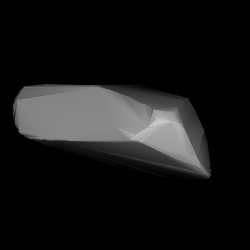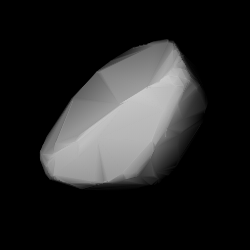Related Research Articles
827 Wolfiana, provisional designation 1916 ZW, is a Florian asteroid from the inner regions of the asteroid belt, approximately 8 kilometers in diameter. It was discovered at Vienna Observatory on 29 August 1916, by Austrian astronomer Johann Palisa, who named it after German astronomer Max Wolf. The assumed stony asteroid has a rotation period of 4.0654 hours.
1047 Geisha, provisional designation 1924 TE, is a stony Florian asteroid from the inner regions of the asteroid belt, approximately 11 kilometers in diameter. It was discovered on 17 November 1924, by German astronomer Karl Reinmuth at the Heidelberg-Königstuhl State Observatory in southwest Germany. The asteroid was named after the British musical The Geisha.

1129 Neujmina is an Eos asteroid from the outer regions of the asteroid belt. It was discovered on 8 August 1929, by astronomer Praskoviya Parchomenko at the Simeiz Observatory on the Crimean peninsula. The stony S-type asteroid has a rotation period of 5.1 hours and measures approximately 34 kilometers in diameter. It was named after Soviet astronomer Grigory Neujmin.

1286 Banachiewicza is an elongated Eos asteroid from the outer regions of the asteroid belt. It was discovered on 25 August 1933, by Belgian astronomer Sylvain Arend at the Royal Observatory of Belgium in Uccle. The stony S-type asteroid has a rotation period of 8.6 hours and measures approximately 21 kilometers in diameter. It was named after Polish astronomer Tadeusz Banachiewicz.
1411 Brauna, provisional designation 1937 AM, is a stony Eoan asteroid from the outer regions of the asteroid belt, approximately 31 kilometers in diameter. It was discovered on 8 January 1937, by German astronomer Karl Reinmuth at the Heidelberg-Königstuhl State Observatory in Germany. The asteroid was named after Margret Braun, wife of Heidelberg astronomer Heinrich Vogt.

1588 Descamisada, provisional designation 1951 MH, is an Eos asteroid from the outer region of the asteroid belt, approximately 18 kilometers in diameter. It was discovered on 27 June 1951, by astronomer Miguel Itzigsohn at the La Plata Astronomical Observatory in La Plata, Argentina, and named in honor of Eva Perón.
1184 Gaea, provisional designation 1926 RE, is an Aerian asteroid from the central regions of the asteroid belt, approximately 20 kilometers in diameter. It was discovered on 5 September 1926, by astronomer Karl Reinmuth at the Heidelberg-Königstuhl State Observatory in southwest Germany. The asteroid was named after the goddess of Earth, Gaea (Gaia), from Greek mythology.
1199 Geldonia, provisional designation 1931 RF, is an Eoan asteroid from the outer regions of the asteroid belt, approximately 32 kilometers in diameter. It was discovered on 14 September 1931, by Belgian astronomer Eugène Delporte at the Royal Observatory of Belgium in Uccle. The asteroid was named after the Belgian town of Jodoigne.
1532 Inari, provisional designation 1938 SM, is a stony Eoan asteroid from the outer regions of the asteroid belt, approximately 28 kilometers in diameter. Discovered by Yrjö Väisälä at Turku Observatory in 1938, it was later named for Lake Inari in northern Finland.
1780 Kippes, provisional designation A906 RA, is an Eoan asteroid from the outer regions of the asteroid belt, approximately 28 kilometers in diameter. It was discovered on 12 September 1906, by astronomer August Kopff at the Heidelberg-Königstuhl State Observatory in southwest Germany. The asteroid was named after German Catholic priest and amateur astronomer Otto Kippes.
1755 Lorbach, provisional designation 1936 VD, is a stony Eoan asteroid from the outer region of the asteroid belt, approximately 25 kilometers in diameter.
1287 Lorcia, provisional designation 1933 QL, is an Eoan asteroid from the outer regions of the asteroid belt, approximately 22 kilometers in diameter. It was discovered by Belgian astronomer Sylvain Arend at the Royal Observatory of Belgium in Uccle on 25 August 1933. The asteroid was named for Laura de Sołohub Dikyj, wife of Polish astronomer Tadeusz Banachiewicz.
2905 Plaskett, provisional designation 1982 BZ2, is a stony Gefionian asteroid from the central regions of the asteroid belt, approximately 10 kilometers in diameter. It was discovered on 24 January 1982, by American astronomer Edward Bowell at the Anderson Mesa Station near Flagstaff, Arizona. The asteroid was named after Canadian astronomers John Stanley Plaskett and Harry Hemley Plaskett.
1297 Quadea, provisional designation 1934 AD, is an Eoan asteroid from the outer regions of the asteroid belt, approximately 23 kilometers in diameter. It was discovered on 7 January 1934, by astronomer Karl Reinmuth at the Heidelberg-Königstuhl State Observatory in Germany. The asteroid was named for the parents-in-law of the discoverer's brother.
3790 Raywilson, provisional designation 1937 UE, is a carbonaceous Themistian asteroid from the outer regions of the asteroid belt, approximately 12 kilometers in diameter. It was discovered on 26 October 1937, by astronomer Karl Reinmuth at the Heidelberg-Königstuhl State Observatory in Heidelberg, Germany. The C-type asteroid has a rotation period of 4.65 hours. It was named for English physicist Raymond Wilson.
1416 Renauxa, provisional designation 1937 EC, is an Eon asteroid from the outer regions of the asteroid belt, approximately 29 kilometers in diameter. It was discovered on 4 March 1937, by French astronomer Louis Boyer at the Algiers Observatory in Algeria, North Africa. It was named after Joseph Renaux, an astronomer at the discovering observatory.

1364 Safara, incorrectly designated 1935 VB, is an Eoan asteroid from the outer regions of the asteroid belt, approximately 25 kilometers in diameter. It was discovered on 18 November 1935, by French astronomer Louis Boyer at the Algiers Observatory in Algeria, North Africa. The asteroid should have been designated 1935 WB, as the letter "V" only covers discoveries made during 1–15 November. It was named after André Safar, presumably an acquaintance of the discoverer from Algiers.
1711 Sandrine, provisional designation 1935 BB, is a stony Eoan asteroid from the outer region of the asteroid belt, approximately 23 kilometers in diameter.
2443 Tomeileen, provisional designation A906 BJ, is a stony Eoan asteroid from the outer regions of the asteroid belt, approximately 32 kilometers in diameter. It was discovered on 24 January 1906, by German astronomer Max Wolf at the Heidelberg-Königstuhl State Observatory in Heidelberg, Germany. The S-type asteroid was named after the parents of British astronomer Brian G. Marsden. It has a rotation period of 3.97 hours.

5357 Sekiguchi is an Eos asteroid from the outer region of the asteroid belt, approximately 15 kilometers in diameter. It was discovered on 2 March 1992, by Japanese amateur astronomers Tetsuya Fujii and Kazuro Watanabe at the Kitami Observatory in eastern Hokkaidō, Japan. The asteroid was later named after Japanese astronomer Tomohiko Sekiguch.
References
- 1 2 3 4 5 "JPL Small-Body Database Browser: 1410 Margret (1937 AL)" (2017-09-30 last obs.). Jet Propulsion Laboratory . Retrieved 25 October 2017.
- 1 2 3 Schmadel, Lutz D. (2007). "(1410) Margret". Dictionary of Minor Planet Names. Springer Berlin Heidelberg. p. 114. doi:10.1007/978-3-540-29925-7_1411. ISBN 978-3-540-00238-3.
- 1 2 "Asteroid 1410 Margret – Nesvorny HCM Asteroid Families V3.0". Small Bodies Data Ferret. Retrieved 26 October 2019.
- 1 2 3 Masiero, Joseph R.; Grav, T.; Mainzer, A. K.; Nugent, C. R.; Bauer, J. M.; Stevenson, R.; et al. (August 2014). "Main-belt Asteroids with WISE/NEOWISE: Near-infrared Albedos". The Astrophysical Journal. 791 (2): 11. arXiv: 1406.6645 . Bibcode:2014ApJ...791..121M. doi:10.1088/0004-637X/791/2/121 . Retrieved 25 October 2017.
- 1 2 "1410 Margret (1937 AL)". Minor Planet Center. Retrieved 25 October 2017.
- 1 2 Nesvorný, D.; Broz, M.; Carruba, V. (December 2014). "Identification and Dynamical Properties of Asteroid Families". Asteroids IV. pp. 297–321. arXiv: 1502.01628 . Bibcode:2015aste.book..297N. doi:10.2458/azu_uapress_9780816532131-ch016. ISBN 9780816532131.
- ↑ "LCDB Data for (1410) Margret". Asteroid Lightcurve Database (LCDB). Retrieved 25 October 2017.